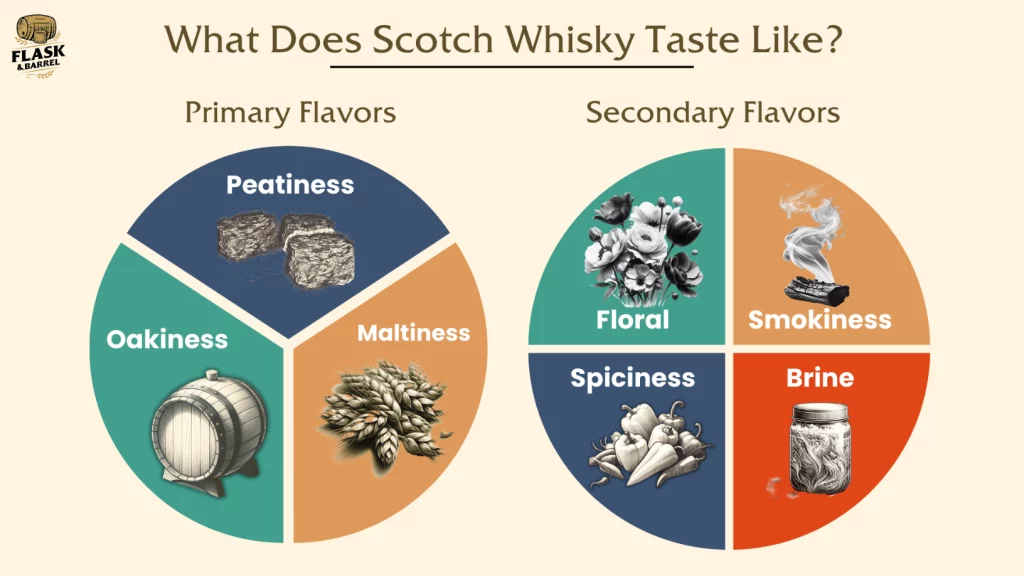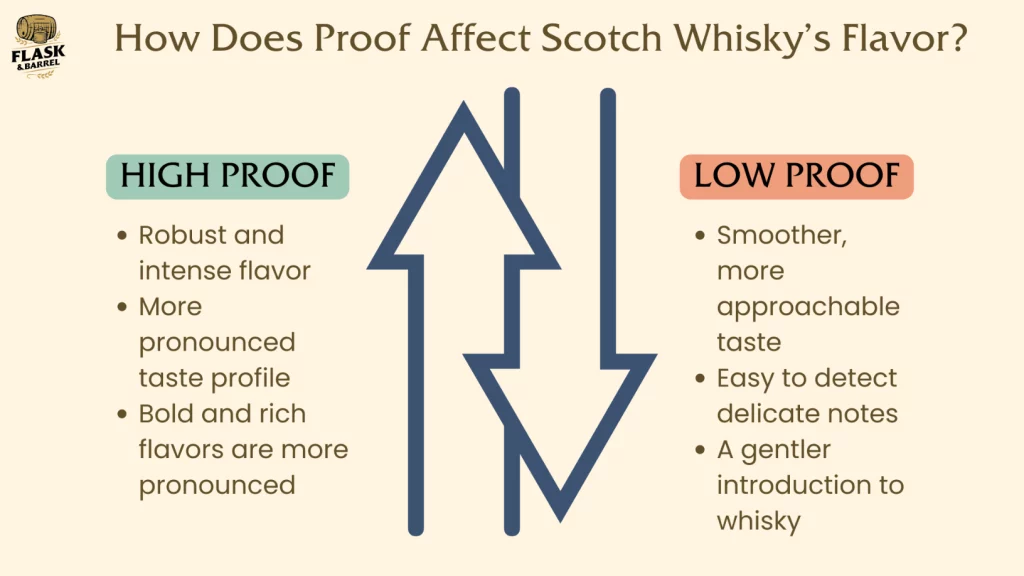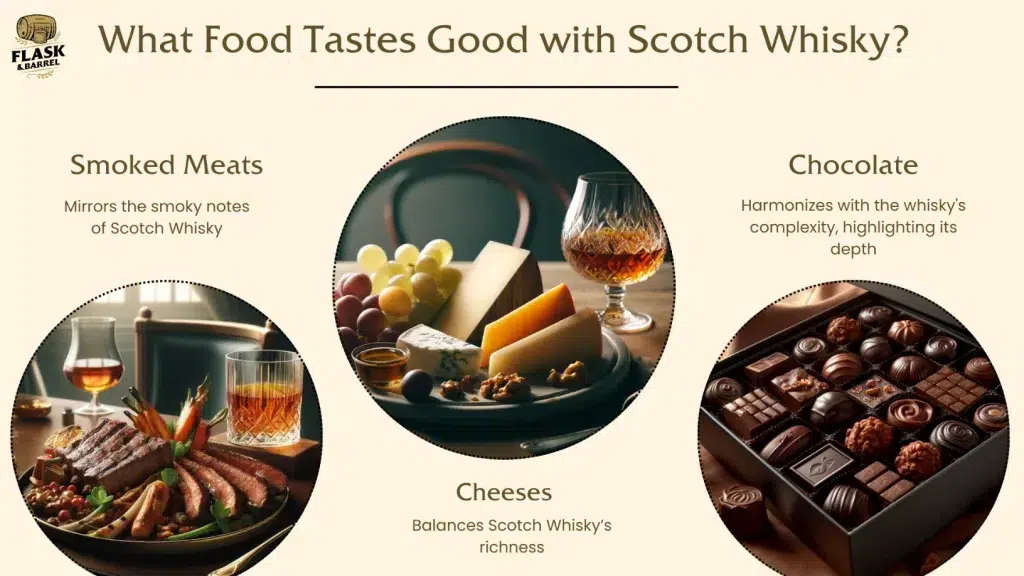Scotch whisky, often hailed as the crown jewel of spirits, commands a prestigious position in the pantheon of global whiskies. Its depth and complexity set it apart, offering a tapestry of tastes that are as varied as the Scottish landscapes from which they hail. This venerable drink distinguishes itself with a richness and variety that make Scotch whisky a category unto itself, celebrated for its unparalleled array of flavors.
At the heart of Scotch whisky’s allure are its primary expressions: Single Malt, Single Grain, Blended Malt, Blended Grain, and Blended Scotch Whiskies, each bringing its own unique profile to the fore. Among these, Single Malt Scotch, crafted from malted barley in pot stills at a single distillery, is often celebrated for its depth and complexity, while Blended Scotch Whiskies offer a harmonious complexity achieved through the artful blending of different whiskies. Delving deeper, the essence of Scotch whisky is defined by a diverse spectrum of flavors, production nuances, regional influences, and maturation processes.
The subsequent sections will unfold these layers, offering a comprehensive exploration of the distinct characteristics that define Scotch whisky. From the peaty, smoky whiskies of Islay to the light, floral notes of the Lowlands and the rich, fruitiness of Speyside malts, this guide will navigate the rich heritage and sensory experiences that Scotch whisky provides, including recommendations for pairing to enhance its enjoyment.
What Does Scotch Whisky Taste Like?
Scotch whisky presents a complex flavor profile that varies widely across its different types and regions of production. At its core, Scotch can exhibit a spectrum of primary flavors such as peatiness, oakiness, and maltiness, each contributing to the distinct character of the whisky. Secondary flavors, including floral notes, spiciness, smokiness, and brine, add layers of complexity and depth.

The smoky quality, a hallmark for many Scotch whiskies, is primarily derived from the peat used in the malting process, imparting a unique taste that is both revered and distinctive. The taste of Scotch whisky also changes significantly depending on its region of origin, from the robust and smoky whiskies of Islay to the gentle, fruity expressions found in the Highlands. Additionally, factors such as proof and cask aging play crucial roles in shaping the final flavor profile of Scotch, influencing everything from intensity to subtlety in taste.
This rich tapestry of flavors makes Scotch whisky a diverse and rewarding spirit to explore, offering something for every palate.
What are the Primary Flavors in Scotch Whisky?
The primary flavors in Scotch whisky, which form the foundation of its intricate taste profile, include peatiness, oakiness, and maltiness. Peatiness offers a distinctive smoky flavor, a result of using peat smoke to dry malted barley, a process that imparts a deep, earthy character to the whisky. Oakiness comes from the aging process in oak barrels, where the spirit acquires vanilla, toffee, and sometimes spicy notes, adding richness and complexity.
Maltiness, indicative of the whisky’s grain origins, brings a sweet, cereal-like quality to the forefront, grounding the whisky with a solid base flavor. These primary flavors serve as the pillars of Scotch whisky’s identity, providing a robust framework upon which secondary flavors and regional characteristics build to form the full, rich tapestry of Scotch whisky’s taste.
Peatiness
Peatiness in Scotch whisky delivers a distinctively smoky flavor, a characteristic derived from drying malted barley over a peat-fueled fire. This process imbues the whisky with an earthy, sometimes medicinal quality, reminiscent of the rugged Scottish landscapes. The intensity of peatiness can vary, offering everything from a subtle whisper to a bold, smoky embrace, significantly influencing the overall flavor profile of the whisky.
Oakiness
Oakiness arises from the maturation process in oak casks, where Scotch whisky develops its complexity and depth over time. This interaction with oak wood introduces a spectrum of flavors, including vanilla, caramel, coconut, and spices, enriching the whisky with a warm, rich character. The type of oak, the history of the barrel, and the length of aging all play pivotal roles in shaping the oaky nuances, making it a critical factor in the whisky’s final taste.
Maltiness
Maltiness is a fundamental flavor in Scotch whisky, highlighting its grain-based origins. It brings a sweet, biscuity quality to the spirit, reminiscent of barley sugar, with hints of nuts and dried fruits. This flavor base provides a counterbalance to the more intense notes of peat and oak, offering a harmonious blend that underscores the whisky’s complexity.
Maltiness is especially pronounced in single malt Scotches, where the character of the malted barley shines through.
What are the Secondary Flavors in Scotch Whisky?
Beyond the foundational notes of peatiness, oakiness, and maltiness, Scotch whisky is further characterized by a range of secondary flavors that add depth and intricacy to its profile. These include floral, spiciness, smokiness, and brine. Floral notes can range from the light touch of heather to the more pronounced aroma of fresh flowers, adding a delicate layer to the whisky.
Spiciness introduces a warming sensation, with hints of cinnamon, nutmeg, or pepper, enriching the whisky’s complexity. Smokiness, distinct from the earthy peatiness, often brings a more refined, wood-fired essence to the palate. Lastly, brine offers a nod to Scotch whisky’s coastal heritage, with a subtle saltiness that can evoke the sea.
These secondary flavors weave together with the primary ones, creating a multifaceted sensory experience unique to each bottle of Scotch whisky.
Floral
Floral flavors in Scotch whisky evoke the essence of Scotland’s natural landscape, ranging from the subtle scent of wild heather to the more pronounced notes of fresh blossoms. These delicate nuances contribute a lightness and elegance to the whisky, offering a contrast to its more robust flavors.
Spiciness
Spiciness in Scotch whisky adds a dynamic layer of warmth and complexity. Flavors such as cinnamon, nutmeg, and black pepper can emerge, providing a piquant counterpoint that enlivens the palate and deepens the overall tasting experience.
Smokiness
Distinct from the earthy tones of peat, smokiness in Scotch whisky often resembles the refined aroma of wood smoke. This flavor can impart a sense of depth and intensity, reminiscent of a cozy fire, adding richness and a lingering finish to the whisky.
Brine
Brine introduces a subtle saline quality to Scotch whisky, a nod to the spirit’s coastal heritage. This hint of saltiness can enhance the whisky’s complexity, bringing balance to its sweeter and smokier notes, and evoking the rugged, maritime landscapes of Scotland.
What Makes Scotch Smoky?
The smoky characteristic of Scotch whisky primarily originates from the peat used during the malting process. Peat, a dense, carbon-rich material formed in waterlogged soils, is dried and then burned to create smoke. This smoke is used to dry malted barley, imbuing the grains with a distinctive smoky flavor.
The extent of this smokiness can vary widely, influenced by the duration and intensity of the peat smoke exposure. Additionally, the type and origin of the peat can introduce subtle variations in flavor, ranging from medicinal to woody notes. This unique process not only distinguishes Scotch from other whiskies but also contributes to the rich tapestry of flavors found within the category, making smokiness a signature trait of many Scotch whiskies.
Does The Best Scotch Whisky Differ by Region?
The best Scotch whisky may differ by region, because taste is profoundly influenced by its place of origin, with each area of Scotland imparting unique characteristics to its whiskies. Islay, for instance, is renowned for its peaty and smoky whiskies, a reflection of the abundant peat and the maritime climate. Speyside, home to the largest number of distilleries, produces whiskies that are generally rich and sweet, often with fruit, nut, and malt notes.
Highland whiskies vary widely due to the region’s vast geography, offering everything from light and floral to rich and smoky flavors. The Lowlands produce lighter, gentle and grassy whiskies, while Campbeltown whiskies are known for their salty and briny characteristics, with a hint of peat. This regional diversity allows for a broad spectrum of flavors within Scotch whisky, making it a spirit with unparalleled variety.
How Does Proof Affect Scotch Whisky’s Flavor?
The proof of Scotch whisky, a measure of its alcohol content, plays a significant role in shaping its flavor profile. High proof whiskies, with a higher alcohol concentration, tend to deliver more intense and bold flavors, often with a pronounced warmth or heat on the palate. This heightened level of alcohol can amplify the inherent characteristics of the whisky, making the tasting experience more robust.

On the other hand, low proof whiskies, which have a lower alcohol content, are generally smoother and more mellow, allowing subtler flavors and nuances to emerge more prominently. The adjustment of water, either during production or before consumption, can further modulate the flavor, revealing hidden notes and softening sharper edges. Thus, the proof of a Scotch whisky intricately influences its taste, offering a spectrum of experiences from bold intensity to gentle subtlety.
High Proof
High proof Scotch whisky, characterized by a higher alcohol content, delivers a robust and intense flavor experience. The elevated alcohol level amplifies the whisky’s inherent characteristics, resulting in a more pronounced taste profile. This intensity can manifest as a warming sensation on the palate, often accompanied by bold, rich flavors that are more pronounced than in their lower-proof counterparts.
Low Proof
Low proof Scotch whisky, with its reduced alcohol content, offers a smoother and more approachable tasting experience. The lower concentration of alcohol allows the subtler, nuanced flavors of the whisky to shine through, making it easier to detect delicate notes that might be overshadowed in higher-proof varieties. This mellow character makes low proof Scotch particularly suited to those seeking a gentler introduction to the world of whisky.
What Food Tastes Good with Scotch Whisky?
Pairing food with Scotch whisky can enhance the sensory experience, as the right combination can complement and elevate the flavors of both the whisky and the dish. Cheese is a classic pairing, with strong, aged varieties like blue cheese or cheddar balancing the whisky’s richness. Chocolate, especially dark or bitter varieties, can harmonize with the whisky’s complexity, highlighting its depth.

For a savory option, smoked meats or seafood can mirror the smoky notes in the whisky, creating a cohesive flavor profile. Lighter Scotch whiskies pair well with fruits and nuts, offering a contrast that accentuates their subtler notes. The key to successful pairing is balancing the intensity and flavor profiles of the whisky with complementary food choices, creating a harmonious dining experience that enhances the enjoyment of both.
Does Scotch Whisky Taste Stronger than Other Alcohol?
The perception of strength in Scotch whisky compared to other types of alcohol can vary significantly, depending on factors such as proof, aging process, and individual flavor profiles. Generally, Scotch whisky, particularly those with a higher proof or intense peaty flavors, may be perceived as stronger or more robust than other spirits. However, this does not necessarily mean it has a higher alcohol content; rather, the rich, complex flavors and smoky characteristics can contribute to a sensation of strength.
In contrast, spirits like vodka might have a similar alcohol content but offer a cleaner, more neutral taste, which could be perceived as less strong. The aging process, which imparts depth and complexity to Scotch whisky, also plays a role in its bold flavor profile, distinguishing it from younger or less complex spirits. Ultimately, the perceived strength of Scotch whisky is a combination of its alcohol content, flavor intensity, and the unique characteristics imparted by its production and maturation processes.
What Does the Term Single-Malt Mean and How Does it Affect the Taste of Scotch?
The term single-malt refers to Scotch whisky that is produced from only water and malted barley at a single distillery by batch distillation in pot stills. This designation has a significant impact on the taste of Scotch, offering a pure expression of the distillery’s character and the specific qualities of the region’s water and barley. Single-malt Scotches tend to have a more distinct and pronounced flavor profile compared to blended Scotches, which combine whiskies from multiple distilleries.
The meticulous production process of single-malts, including the choice of barley, the specifics of the malting process, and the aging in selected casks, contributes to a depth of flavor and complexity that is highly prized among whisky connoisseurs. As a result, single-malt Scotch whiskies provide a unique tasting experience, showcasing a range of flavors from the subtle and smooth to the rich and peaty, reflecting the singular essence of their origin.
What is the Significance of Cask Aging on the Taste of Scotch?
Cask aging is a pivotal process in the production of Scotch whisky, fundamentally influencing its flavor, color, and overall character. During aging, the whisky interacts with the wood of the cask, absorbing a myriad of flavors and compounds. This interaction introduces notes of vanilla, caramel, and spices, and can impart a smoother, more rounded profile to the whisky.
The type of cask used, whether it’s American oak, European oak, or previously used to age sherry, bourbon, or wine, plays a crucial role in defining the final taste. The length of time the whisky spends in the cask also affects its complexity and depth; longer aging typically results in a richer, more nuanced flavor. This process of maturation allows Scotch whisky to develop a unique and distinctive taste, with each cask contributing its own character to the finished product.
How Does The Taste of Scotch Whisky Compare to Other Spirits?
Scotch whisky stands out in the world of spirits due to its distinctive taste profile, deeply influenced by its geographical origin, production methods, and aging process. Compared to Japanese whisky, which often presents a smoother, more subtle flavor profile with a focus on precision and balance, Scotch tends to offer a broader range of flavors, from deeply peaty to richly floral. Irish whiskey, typically triple-distilled for smoothness, generally has a lighter, fruitier character compared to the often more robust and complex flavors found in Scotch.

Bourbon, with its mandatory corn-based mash and new oak barrel aging, delivers sweeter, more caramel and vanilla notes, making it distinctly different from Scotch’s wide flavor spectrum that includes everything from smoky and peaty to light and floral notes. Each spirit reflects its unique heritage and production techniques, contributing to the rich diversity of flavors available to enthusiasts.
The Taste of Scotch Whisky vs. Japanese Whisky
Scotch whisky and Japanese whisky share a common heritage, yet they diverge significantly in taste. Scotch often features a wide array of flavors, from the intensely peaty and smoky to the delicately floral and fruity. Japanese whisky, in contrast, tends to lean towards a more refined, subtle profile with an emphasis on balance and harmony, often showcasing light peat, fruit, and malt.
The Taste of Scotch Whisky vs. Irish Whisky
The difference between Scotch whisky and Irish whiskey primarily lies in their production methods and resulting flavor profiles. Scotch is known for its diversity, offering everything from deep, smoky, peaty flavors to light, sweet, and floral notes. Irish whiskey, characteristically triple-distilled, presents a smoother, lighter taste with prominent notes of fruit and vanilla, making it generally more approachable.
The Taste of Scotch Whisky vs. Bourbon
Scotch whisky and Bourbon represent two distinct traditions in whiskey production, leading to markedly different taste experiences. Bourbon, with its corn-dominant mash bill and new oak barrel aging, typically exhibits sweeter flavors, rich in caramel, vanilla, and oak. Scotch whisky, depending on the region and production method, offers a broader palette ranging from smoky and peaty to smooth and fruity, reflecting its rich geographical and historical diversity.
How To Drink Scotch Whisky?
In knowing how to drink Scotch whisky, the choice of glass can significantly influence the tasting experience. The Glencairn glass is the preferred option for many enthusiasts and experts for drinking Scotch whisky. Its unique tulip shape is designed to concentrate the whisky’s aromas, allowing for a deeper sensory exploration. The narrow opening helps to direct the aromas towards the nose, enhancing the whisky’s complex bouquet, while the wide bowl allows for the spirit to be swirled, revealing its full range of flavors.
This design not only optimizes the olfactory experience but also enhances the overall enjoyment of the whisky, making the Glencairn glass an ideal choice for those looking to fully appreciate the nuances of Scotch.

